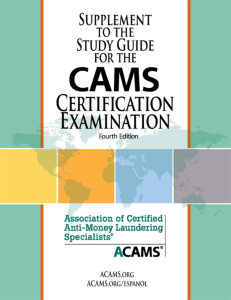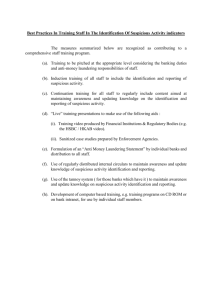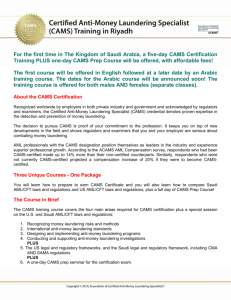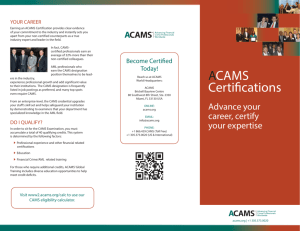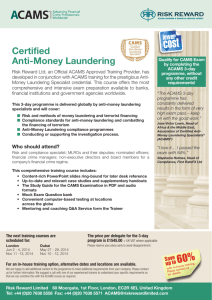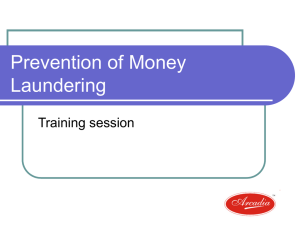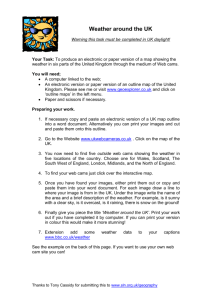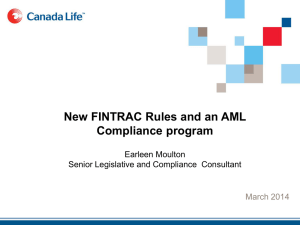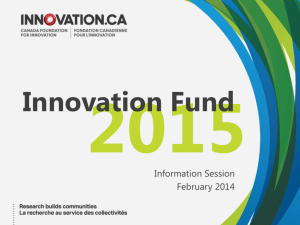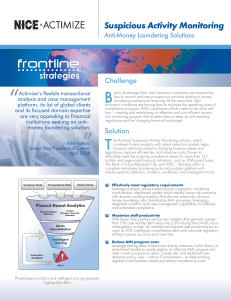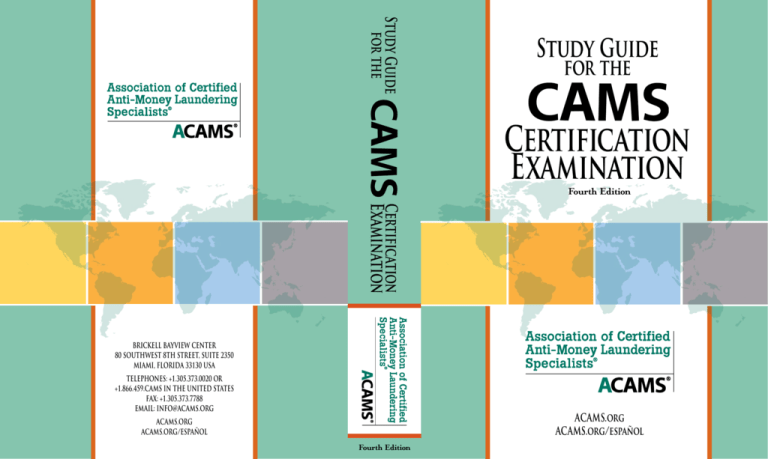
Study Guide
for the
Study Guide
for the
Certification
Examination
Fourth Edition
Certification
Examination
brickell bayview center
80 Southwest 8th Street, Suite 2350
Miami, Florida 33130 USA
Telephones: +1.305.373.0020 or
+1.866.459.CAMS in the united states
Fax: +1.305.373.7788
Email: info@ACAMS.org
ACAMS.org
ACAMS.org/español
ACAMS.org
ACAMS.org/español
Fourth Edition
Study Guide
for the
Certification
Examination
Fourth Edition
Study Guide
for the
Certification
Examination
Fourth Edition
a publication of the
Study Guide
for the
Certification
Examination
Fourth Edition
Executive Director
Gregory Calpakis, CAMS
Editor
Saskia Rietbroek, CAMS
Contributors
Mary Bhawnani
John Byrne, CAMS
Garry Clement, CAMS
Michael R. McDonald, CAMS
Christopher Myers, CAMS
Eugene M. Propper
John Pyrik, CAMS
Nancy Saur, CAMS
Jeffrey Sklar, CAMS
Production Assistants
Gabrielle Hartmann,CAMS
Rebecca Lentz-Fernandes,CAMS
Association of Certified Anti-Money
Laundering Specialists (ACAMS)
Brickell Bayview Center
80 Southwest 8th Street
Suite 2350
Miami, FL 33130 United States
ACAMS.org
ACAMS.org/espanol
Tel: 1.305.373.0020
Fax: 1.305.373.5229
Fax: 1.305.373.7788
ACAMS.org
E-mail: info@ACAMS.org
Copyright © 2007 by the Association of Certified Anti-Money Laundering Specialists (ACAMS). Miami, USA.
All rights reserved. No part of this publication may be reproduced or distributed, and may not be made
available in any electronic format, without the prior written permission of ACAMS. ISBN: 978-0-9777495-2-2
Table of Contents
Table of Contents
Chapter 1: Introduction.................................... 1
About the Association of Certified
Anti-Money Laundering Specialists...............................................................................1
n. The Mission of the Association of Certified
Anti-Money Laundering Specialists.....................................................................2
n. Objectives............................................................................................................3
n. Membership ........................................................................................................4
CAMS-A Unique Certification.........................................................................................5
n. Why CAMS..........................................................................................................5
n. Purpose of Certification.......................................................................................6
n. CAMS Certification Provides Career Benefits.....................................................6
n. How Is The CAMS Examination Developed?......................................................7
n. Who May Take The CAMS Certification Examination?........................................8
n. Content of the CAMS Examination......................................................................9
n. The CAMS Candidate Handbook and the Process for Applying for the
Certification Examination...................................................................................10
n. CAMS Recertification.........................................................................................11
Study Guide for the Certification Examination...........................................................11
n. Organization of The Guide.................................................................................11
n. Purpose.............................................................................................................12
n. Audience............................................................................................................12
n. Conclusion.........................................................................................................13
v
Study Guide for the CAMS Certification Examination
Chapter 2: Risks and Methods of Money
Laundering and Terrorist Financing............. 15
What is Money Laundering?.........................................................................................15
Three Stages in the Money Laundering Cycle............................................................17
The Economic and Social Consequences of Money Laundering.............................20
Methods of Money Laundering....................................................................................28
n. Banks and Other Depository Institutions...........................................................28
q.Electronic Transfers of Funds................................................................29
q.Correspondent Banking.........................................................................30
q.Payable-Through Accounts ..................................................................34
q.Concentration Accounts.........................................................................35
q.Private Banking.....................................................................................37
q.Smurfing/Structuring..............................................................................40
q.Bank Complicity.....................................................................................46
q.Credit Unions or Building Societies.......................................................47
n. Non-Bank Financial Institutions ........................................................................49
q.Credit Card Industry..............................................................................49
q.Money Remitters and Money Exchange Houses..................................50
q.Insurance Companies............................................................................53
q.Securities Broker-Dealers......................................................................58
n. Non-Financial Businesses and Professions .....................................................62
q.Casinos and Other Businesses Associated with Gambling...................62
q.Dealers in High-Value Items (Precious Metals, Jewelry, Art, etc.)............ 64
q.Travel Agencies.....................................................................................70
q.Vehicle Sellers.......................................................................................71
q.Gatekeepers: Notaries, Accountants, Auditors, Lawyers.......................73
vi
Table of Contents
q.Investment and Commodity Advisors....................................................76
q.Trust and Company Service Providers..................................................79
q.Real Estate Industry .............................................................................81
q.Manipulation of Prices in Import and Export Transactions ...................84
q.Black Market Peso Exchange................................................................86
Money Laundering Risks Associated
with New Technologies.................................................................................................89
n. Online or Internet Banking.................................................................................89
n. Internet Casinos.................................................................................................91
n. Prepaid Cards and E-Cash................................................................................95
Money Laundering Risks of Structures
Designed to Hide Beneficial Ownership.....................................................................98
n. Shell Companies................................................................................................98
n. Trusts...............................................................................................................104
n. Bearer Bonds and Securities...........................................................................105
Terrorist Financing......................................................................................................106
n. Differences and Similarities Between Terrorist
Financing and Money Laundering...................................................................106
n. Detecting Terrorist Financing...........................................................................109
n. Hawala and Other Informal Value Transfer Systems ......................................114
n. Charities or Non-Profit Organizations..............................................................117
Summary......................................................................................................................118
Review Questions.......................................................................................................120
Chapter 3: Compliance Standards for
Anti-Money Laundering and Combating the
Financing of Terrorism................................. 121
vii
Study Guide for the CAMS Certification Examination
Financial Action Task Force.......................................................................................121
n. Members and Observers.................................................................................122
n. Objectives........................................................................................................123
n. Financial Action Task Force 40 Recommendations.........................................126
n. FATF Guidance on Dismantling Terrorist Financing and “Special
Recommendations”..........................................................................................133
n. Non-Cooperative Countries.............................................................................137
The Basel Committee on Banking Supervision........................................................142
European Union Directives on Money Laundering..................................................149
Regional and Other International Initiatives.............................................................154
n. Regional FATF-Style Bodies ...........................................................................154
q.Asia/Pacific Group on Money Laundering ..........................................154
q.Caribbean Financial Action Task Force...............................................157
q.South American Financial Action Task Force (GAFISUD)...................159
q.Middle East and North Africa Financial Action Task Force..................160
q.Eurasian Group on Combating Money
Laundering and Terrorist Financing.....................................................160
q.Eastern and South African Anti-Money Laundering Group . ...............161
n. Other Anti-Money Laundering Initiatives..........................................................161
q.Organization of American States – Inter-American
Drug Abuse Control Commission (CICAD)..........................................161
q.Egmont Group of Financial Intelligence Units ....................................165
q.Wolfsberg Group ................................................................................166
q.World Bank and International Monetary Fund.....................................171
n. Other International Organizations....................................................................173
Key U.S. Legislative and Regulatory Initiatives
Applied to Transactions Internationally....................................................................174
n. USA Patriot Act................................................................................................174
n. The Reach of the U.S. Criminal Money Laundering
and Civil Forfeiture Laws.................................................................................179
viii
Table of Contents
n. Office of Foreign Assets Control......................................................................181
Summary......................................................................................................................182
Review Questions.......................................................................................................188
Chapter 4: Anti-Money Laundering
Compliance Program................................... 189
Introduction..................................................................................................................189
Assessing Risk and Developing a Risk Scoring Model...........................................190
n. Introduction......................................................................................................190
q.Factors to Determine Risk...................................................................191
n. What Risks Do Your Customers Pose?...........................................................192
q.Geographical Location.........................................................................192
q.Type of Business.................................................................................193
q.Legal and Transaction Structures . ....................................................194
n. What Risks Do Your Products or Services Pose? ..........................................194
q.High- Risk Products, Services and Countries......................................196
The Elements of an AML Program.............................................................................198
n. Internal Policies, Procedures and Controls......................................................198
n. Compliance Officer..........................................................................................201
n. Training............................................................................................................203
q.Whom to Train.....................................................................................203
q.What to Train In...................................................................................204
q.How to Train........................................................................................205
q.When to Train......................................................................................206
q.Where to Train ....................................................................................207
ix
Study Guide for the CAMS Certification Examination
n. Audit.................................................................................................................207
Compliance Culture and Senior Management’s Role..............................................211
Know Your Customer..................................................................................................214
n. Main Elements of a KYC Program...................................................................214
n. Account Opening, Customer Identification and Verification.............................215
q.Name Checking Lists...........................................................................221
q.Consolidated KYC...............................................................................223
Know Your Employee..................................................................................................224
Suspicious or Unusual Activity Monitoring and Reporting.....................................228
Red Flags or Indicators of Money Laundering.........................................................230
n. Suspicious Customer Behavior........................................................................233
n. Suspicious Customer Identification Circumstances.........................................234
n. Suspicious Cash Transactions.........................................................................235
n. Suspicious Non-Cash Deposits.......................................................................236
n. Suspicious Wire Transfer Transactions...........................................................237
n. Suspicious Safe Deposit Box Activity..............................................................238
n. Suspicious Activity in Credit Transactions.......................................................238
n. Suspicious Commercial Account Activity ........................................................239
n. Suspicious Trade Financing Transactions.......................................................239
n. Suspicious Investment Activity.........................................................................240
n. Suspicious Employee Activity..........................................................................240
n. Suspicious Activity in a Money Remitter/Currency
Exchange House Setting.................................................................................241
n. Suspicious Activity in an Insurance Company Setting.....................................241
n. Suspicious Activity in a Broker-Dealer Setting.................................................242
x
Table of Contents
n. Suspicious Activity Indicators of Black Market Peso
Exchange Money Laundering Method.............................................................243
Electronic Anti-Money Laundering Solutions...........................................................244
Summary......................................................................................................................248
Review Questions.......................................................................................................250
Chapter 5: Conducting or Supporting the
Investigation Process.................................. 251
Introduction..................................................................................................................251
n. When to Conduct an Internal Investigation......................................................252
n. Type of Investigation........................................................................................253
n. Choice of Counsel for the Investigation...........................................................255
n. Media Relations...............................................................................................259
n. Control of Documents and Computer Files......................................................260
n. Notices to Employees......................................................................................261
n. Plan In Advance...............................................................................................261
Investigative Inquiries . ..............................................................................................262
n. Search Warrants..............................................................................................263
n. Orders to Restrain or Freeze Accounts or Assets............................................264
n. Summonses and Subpoenas...........................................................................265
n. If Asked to Hand Over Documents Which Ones Do You Provide?..................269
Criminal Liability for the Institution...........................................................................270
Conducting the Investigation.....................................................................................270
n. Interviewing Employees...................................................................................271
q.Preparing for Employee Interviews......................................................271
xi
Study Guide for the CAMS Certification Examination
q.Attorney-Client Privilege, Applied to Entities and Individuals..............272
q.Conducting the Interviews...................................................................273
n. Documents.......................................................................................................273
q.The Importance of Gathering and Producing Documents...................273
q.Finding and Reviewing the Documents...............................................276
q.Organization of Documents.................................................................277
n. Report of the Investigation...............................................................................278
q.Dissemination of a Written Report.......................................................279
q.Oral Report..........................................................................................279
q.Protecting the Company from Suits Arising from the Report...............279
q.Protecting Investigative Materials from Disclosure..............................280
n. Dealing with the Prosecutor.............................................................................282
Prosecution..................................................................................................................287
Government Investigations........................................................................................288
Exploiting the Internet for Money Laundering Investigations ...............................293
n. Too Much Money.............................................................................................293
n. Unknown Business..........................................................................................294
n. Weird Wires.....................................................................................................296
n. The Final Word................................................................................................298
AML Cooperation Between Countries ......................................................................299
n. IMoLIN.............................................................................................................299
n. Mutual Legal Assistance Treaties....................................................................300
n. Financial Intelligence Units/Financial Investigative Units (FIUs).....................301
n. The Supervisory Channel................................................................................306
n. FATF Recommendations on Cooperation Between Countries........................307
Summary......................................................................................................................308
xii
Table of Contents
Review Questions ......................................................................................................309
Chapter 6: Practice Questions
for Certification Examination...................... 311
Chapter 7: Glossary of
Anti-Money Laundering Terms.................... 327
Chapter 8: Study and Test-Taking
Tips and Techniques.................................... 395
How Do You Learn?.....................................................................................................396
Learning How to Learn................................................................................................399
Avoiding the Traps of Studying.................................................................................401
Good Study Habits......................................................................................................406
Taking the Examination..............................................................................................409
Top 10 Tips for Succeeding in Multiple-Choice Tests..............................................411
Coping with Test Anxiety............................................................................................414
Chapter 9: Guidance Documents and
Reference Materials..................................... 415
Guidance Documents and Reference Materials.......................................................416
Other Websites with Helpful AML Material................................................................421
AML-Related Periodicals............................................................................................423
xiii

